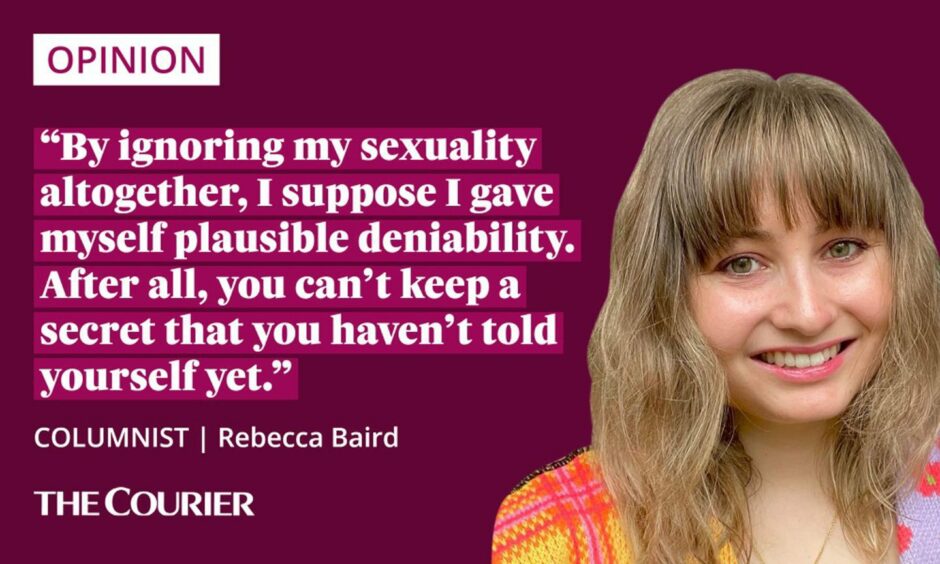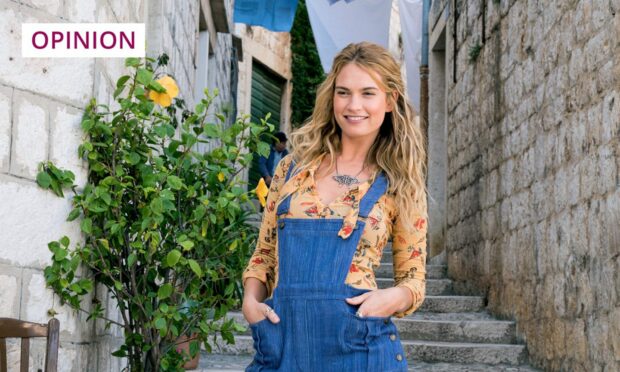It all started with a pair of dungarees.
I was 23. I’d just seen Mamma Mia! 2, where Lily James played a young Donna, complete with a fun, flirty version of the denim overalls Meryl Streep rocked in the original.
Abba-fied fashion exploded on to the high street and days later I found my next ‘signature look’ for exactly 52 pounds sterling.
They were perfect – the perfect shade of blue, with wee retro silver clips and baggy legs that tapered towards the bottom.
I felt like a mud-smeared horse girl and Rachel Green and Marlon Brando all at once, which is to say I felt very cool.
At the time, I thought it was like any other fashion choice.

Maybe it’s my Playstation upbringing talking, but I have this theory that when we get dressed in the morning, we’re picking our character for the day.
Finding a new piece of clothing is, for me, like unlocking a new character, with new powers and strengths and interests.
Who’s that girl who looks like me?
Before the dungarees, there was pink-trouser-Rebecca – she was all tailoring and tough talk, very #girlboss. She helped me get good at being The Journalist Lassie.
Before that, yellow-jumper-Rebecca – obsessed with cooking and candles, romanticising reading books under blankets each night. I didn’t know how much I liked spending time alone before I unlocked her self-worn sunshine.
But the dungarees were different.
The character they unlocked wasn’t who I aimed for – a carefree, wild summer girl like Donna.
It was a girl who looked like me? A me from before I started trying on personalities like outfits. And, no getting away from it, she looked a wee bit fruity.
I’ll be honest; that combo threw me.
Fashionably late to the dating game
My sexuality was never something I paid a lot of mind to growing up, until other people started questioning it for me.
During my teens, the idea of dating was fairly uninteresting. But I liked the idea of eventually finding someone, when I was much, much older.
Unfortunately, since I wasn’t demonstratively boy-mad by age 13, I was interrogated consistently (and judgementally) throughout my adolescence about what I was ‘hiding’.
From other kids’ brutal invasions – “why’ve you never had a boyfriend, you a dyke or something?” – to my family’s gentle prodding – “you know you can tell us anything, don’t you?” – everyone seemed to think my lack of romantic life meant I had some Big Gay Secret.
But as far as I knew, I didn’t. I liked boys, probably – I just wasn’t interested yet.
I wasn’t lying. But by ignoring my sexuality altogether, I suppose I gave myself plausible deniability.
After all, you can’t keep a secret that you haven’t told yourself yet.
But I was pretty sure I wasn’t a lesbian, and anything in between was seen as a stop on the way (lest we forget that Phoebe Buffay song from Friends?)
Fitting in and figuring stuff out
So I was careful to stop doing, wearing or saying anything that might add fuel to the theories of my queerness.
I wore hyper-feminine clothes: skirts and dresses and high heels, things that I knew made boys want to look at me – which I liked, most of the time.
And at sleepovers, when the lights went out and the late-night whispers started about who fancied who, and who kissed who behind where, I would insist the boys I liked were ‘just my friends’ because I felt the same way about them as I did about some girls, which meant the feeling had to be friendship, right?
(Spoiler alert: Reader, the feeling was not friendship.)
Then one Thursday when I was 17, I fell madly in love with a boy. Just like that.
The questions stopped, in the world and in my head.
Cosplaying… as myself?
Until six years later, now single and in that Topshop changing room, the new-look euphoria hit me like a bus, and my paranoid teenage self jumped out to ask: “Do these make me look a bit…gay?”
I realised that then, for the first time, I wasn’t sure what answer I wanted – and I wasn’t scared of either one. That felt new, so I bought them.
And the character I unlocked was me, but yes – ‘a bit gay’.
I spent the next several years ‘cosplaying as bisexual’, as my best friend jokingly puts it.
I adopted a uniform of rolled-up ‘rees and my trusty Dr Martens, picking pastel pinks and floral prints to soften the androgyny into something that felt like me; not so much rejecting the male gaze as expanding it out into something more.
Was going to joke that the pride flag is the only thing more colourful than my dungaree collection…
…then j remembered I have a pair of dungarees that correspond with each stripe on the flag. pic.twitter.com/XCEX66geN6
— Ciara Haverly (@ciarahav) February 1, 2022
And ever since, dungarees have gone from a costume to my default outfit.
They’re the perfect mix of whimsical and practical, stylish and simple; masculine and feminine.
All the things that, it turns out, I love.
Finding Pride in dungarees
Dungarees are the clothing world’s answer to duality – why have a top and trousers when you can have two in one?! – so it’s no surprise that they’re so popular among the queer community, where binaries of gender and sexuality are so often dissolved.
And since I’ve discovered that ease with duality in my style, I have – surprise, surprise – found it in my personal life too.
Like I’ve watched The Witcher – for the plot – without pretending to myself that I’m any less in love with Yennefer than I am with Geralt.
And I’ve held hands in the air with strangers at a Dodie concert as the lights came up rainbow, joined the chorus of voices singing:
So say that I’m a rainbow, and tell me that I’m bright
When I’m so used to feeling wrong, it makes me feel alright
Before dungarees, I never would’ve gone. I’d have avoided the character I might find there. I wouldn’t have known how to dress her – which is a privileged problem to have.
More than anything, by finding my style in this funny garment that stands somewhere between toddler and lumberjack, I’ve learned that queerness is about much more than who you fancy.
It’s about knowing who you are; unlocking every wee character you’ve got.
Happy Pride, everyone. I’ll be the one in the dungarees.


















Conversation